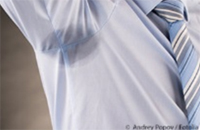Heavy Sweating
When Every Handshake Makes You Feel Like Being “Lost in Transpirationˮ

At least 800.000 people in Germany suffer from excessive sweating, called hyperhydrosis. Dr. Jutta Günter, medical doctor in the Department of Thoracic Surgery (Medical Center – University of Freiburg) explains, how you can check whether your sweating is normal and talks about the medical possibilities to get heavy perspiration under control.
How can I become aware of having hyperhydrosis?
You most likely suffer from hyperhydrosis, if you feel that heavy sweating impairs your activities or interferes with your daily routine in an uncomfortable way. Such excessive transpiration might be caused by stress, emotion or exhaustion; in many cases, however, the patients start to sweat rather spontaneously.
Which body parts are usually affected by heavy sweating?
Normally, the hands, underarms and feet are affected. Some patients even sweat all over the body. Not seldom, this also constitutes a significant emotional charge for the persons concerned. For instance, many people feel embarrassed about presenting their chilly and damp hand to somebody, while others are annoyed of having to change their clothes several times a day. Moreover, excessive formation of sweat on the feet produces an unpleasant smell.
What options are there, to treat hyperhydrosis?
Usually, the first measure is medicative treatment provided by your general physician. The doctor can prescribe or recommend several creams and sprays, that might cause the perspiratory glands to dry out. Furthermore, iontophoresis – i.e. an electric stimulation on the hands, feet or axillas – represents a possible way to stop extensive sweating. An injection of Botox (Botulinum toxin) can also help to decrease hyperhydrosis in the affected area, since this toxin reduces the transmission of neural impulses to the perspiratory glands. Generalised hyperhydrosis may temporarily be treated with pills, but that should not be considered as a long-term solution.
Under what circumstances does surgery become a reasonable option?
Surgery becomes a viable solution in cases, where both medication and conservative treatment efforts have yielded no satisfying or lasting results. In the course of the operation, the part of the nervous system, which is responsible for the regulation of the perspiratory glands of the arm or hand is removed. The nerve in question is cut through at a particular point within the chest, depending on what sort of hyperhydrosis has been diagnosed. About 90 to 95 percent of all patients with excessive hand sweating can be treated successfully. In cases of heavy underarm transpiration, the cure rate is approximately between 75 to 80 percent.
What is the procedure of such an operation?
Nowadays, a so-called sympathicotomy is performed as a minimally invasive and video-assisted operation („keyhole surgery“). During general anaesthesia, two cuts of about 5 millimetres in length are made. Then, a tiny camera and special instruments are inserted into the chest. While observing the operation area on the monitor, the surgeon can look for the relevant sections of the sympathetic nerve cord and treat it electrosurgically. Usually, the patient is released from the hospital on the following day.
Can the operation produce any side effects?
After surgery, more than half of the patients temporarily sweat more in other body regions. However, only a few of them seriously feel affected by that. Other post-operative effects like sweating after meals, for instance, are much less frequent. Fortunately, all these problems improve after some weeks. With a little luck, the patient will afterwards be cured from heavy sweating for the rest of his life.
Which department of the Medical Center – University of Freiburg provides treatment for hyperhydrosis patients?
In our university clinic there are three sides involved in the treatment of hyperhydrosis, namely the Departments of Thoracic Surgery, Dermatology and Plastic Surgery.
- Thoracic Surgery
- Department of Dermatology
- Department of Plastic Surgery
Back